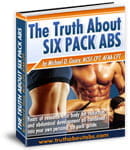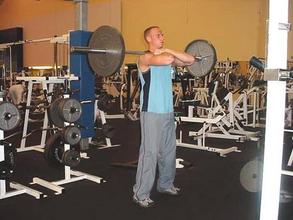by Mike Geary, Certified Nutrition Specialist, Certified Personal Trainer
Author of best seller: The Truth About Six Pack Abs

1. Do more heavy squats and deadlifts!
Yes, I know this sounds crazy since squats and deadlifts don't directly work your arms (except for the grip and forearm strength needed to deadlift heavy weights)... but it's true that regularly performing heavy squats and deadlifts can indirectly help to make your arms bigger and stronger.
The reason is that heavy squatting and/or deadlifting forces the body to release muscle building hormones such as testosterone and growth hormone depending on the resistance level, rep range, rest period, etc.
Generally, heavy weights, lower reps, and longer rest periods stimulate testosterone release, whereas moderate weights, higher rep ranges, and shorter rest periods help to stimulate Growth Hormone release. Therefore, combining both styles of training into your routines on either different days of the week or different cycles, can help to maximize both of these important muscle building hormones.
2. Try my arm-blasting, hormone-maximizing combo sets!
In theory, I think this style of combo I'm going to show you can work well to stimulate some new growth in your arms if you've been stuck at a plateau. In practice, I've actually SEEN it produce results!
My technique involves combining a heavy squat or deadlift (in a very heavy weight and low rep range) with a single-joint exercise for the biceps or triceps (in a higher-rep "pump" style fashion).
So here are 2 ways this could work in separate workouts for example:
Alternating sets (exercise 1a, rest 30-60 seconds, exercise 1b, rest 30-60 seconds, repeat for all sets)
1a. Barbell back squats -- heavy challenging weight - 5 sets of 3-4 reps/set
1b. Barbell or dumbbell curls (or any bicep single-joint exercise) -- 5 sets of 12-15 reps/set; going for "pump"
So you can see how this unusual style of supersetting (or rather, alternating sets), actually combines a testosterone stimulating full body exercise done at a heavy weight with a single joint (isolation) exercise that has the intention of creating more of a bodybuilding "pump".
The other reason this style of alternating sets works is that the single-joint exercise is almost like an "active rest" while your entire body and CNS recovers from the demands of doing heavy, heavy squats.
The same style can work with deadlifts combined with a triceps exercise... for example:
1a. Barbell deadlifts -- heavy challenging weight - 5 sets of 3-4 reps/set
1b. Triceps single-joint exercise (lying dumbbell extensions, cable pressdowns, etc) -- 5 sets of 12-15 reps/set; going for "pump"
Again, this seems like an unusual combo for alternating sets, but actually works out quite well, because after deadlifting very heavy weights, performing a high rep "pump" exercise for the triceps is a welcome relief for your body and your mind to help recover and get ready for the next set of heavy deads.
3. Food, food, food!
Remember that the title of this article meant that your goal was to add more muscle SIZE to your arms, and in order to add muscle to your body, you need to be in a slight caloric surplus.
Ok... so the first 2 tips might have been a little unusual, but this one should be obvious.
Although it is possible for some people (especially beginners) to add muscle mass while reducing calories below their maintenance levels, it is extremely hard for any type of hardgainer to build any muscle at all if your calories aren't high enough. Remember, we weren't talking about a fat loss routine here... we were talking about gaining muscle and getting bigger arms... so that is going to require some extra calories above your maintenance.
Don't go crazy and think this means eating tons of junk food... you should still stick to clean healthy foods.
I wouldn't obsess over exact ratios of carbs, protein, or fats either... your body needs all 3 for different reasons... protein as the building blocks of muscle; carbs for muscle glycogen, energy during the workouts, and insulin response post-workout; and healthy fats to help maximize your muscle building hormones.
This is more than just about arms and pecs though... if you're dedicated to building a ripped, strong, powerful body from head to toe, I HIGHLY recommend my good friend and colleague Kyle's new website here:
Hope you enjoyed the article and have fun with the training!
Feel free to email (or facebook it, tweet it, etc) this link to any of your friends that might want to build bigger arms or more muscle overall.
Certified Personal Trainer
Certified Nutrition Specialist
Author of best-selling program: The Truth about Six Pack Abs







 If you liked these training ideas, my internationally best-selling ebook
If you liked these training ideas, my internationally best-selling ebook  1. Onions = Amazing Superfood... Eat onions daily if possible.
1. Onions = Amazing Superfood... Eat onions daily if possible. Tip #3. Example of the Glycemic Index (GI) being fairly useless
Tip #3. Example of the Glycemic Index (GI) being fairly useless They don't have to put what they claim in the bottle! There's no regulations on supplements to assure integrity or quality.
They don't have to put what they claim in the bottle! There's no regulations on supplements to assure integrity or quality.






